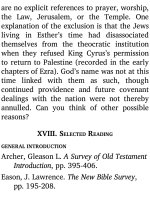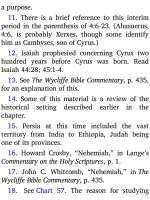Jensens survey of the old testament adam 408
Bạn đang xem bản rút gọn của tài liệu. Xem và tải ngay bản đầy đủ của tài liệu tại đây (80.23 KB, 4 trang )
A little may be learned about the man
John from the book he wrote, although one
is not usually aware of the author, as John’s
gospel is being studied. From that
standpoint, the authorship may rest in
anonymity, as suggested symbolically by
someone’s remark that “this gospel was
written by the hand of an angel.”
B. PLACE AND DATE OF WRITING
The latter years of John’s life were spent
around Ephesus, hub city of Asia Minor,
where the apostle was teaching, preaching,
and writing. The advanced nature of John’s
gospel points to the fact that the other three
gospels had already been written, and that a
period of time had elapsed since their
writing. Now the church’s need was for a
restatement of the same story of Christ, but
with more re ection and interpretation
combined with the narrative. On the basis of
all this it may be concluded that John wrote
his gospel toward the end of the century, or
around A.D. 85, while he was ministering at
Ephesus.3
Ten years later, around A.D. 95, John was
exiled by Emperor Domitian to the Island of
Patmos, where he wrote the book of
Revelation (cf. Rev. 1:9).
C. ORIGINAL READERS
By the time John wrote his gospel the
church had matured in its transition from a
Jewish exclusivism (cf. Acts 10) to a
universal outreach. Recall from your study
of Luke, written about twenty- ve years
earlier, that the third gospel had helped men
understand the broader scope of Christ’s
message by showing the gospel’s universal
application. By the time of the appearance of
John’s gospel it was very natural for the
message of this fourth gospel to be directed
to the world at large. There are many
internal evidences of this universal outreach.
For example, John knew as he wrote that
not many of his readers would be Jews. So
he translated Hebrew and Aramaic words
(e.g., Siloam, 9:7; Gabbatha, 19:13; and
Golgotha, 19:17), and he explained Jewish
religious practices (e.g., the burial custom of
19:40). There are many other characteristics
of his writing that reveal its universal
application.
Despite this universal avor of the fourth
gospel, it has been observed that the
account “is saturated with the thoughts,
imagery, and language of the Old
Testament.”4 This con rms the unity of both
testaments of the Bible.
D. STYLE OF WRITING
There is a basic simplicity about the
language and structure of the fourth gospel,
whereas the meaning of its message ranges
from the perspicuous (e.g., 3:16) to the
mystical (e.g., 1:1). Luther wrote, “Never in
my life have I read a book written in simpler
words than this, and yet the words are
inexpressible.” Another theologian has
expressed it this way: “The noble simplicity
and the dim mystery of the narration, the
tone of grief and longing, with the light of
love shedding its tremulous beam on the
whole — these impart to the Gospel of John
a peculiar originality and charm, to which
no parallel can be found.”5
John is a book of contrasts, moving
quickly from grief and sadness to joy and
gladness, from the storms of opposition to
the peace of fellowship, from condescension









